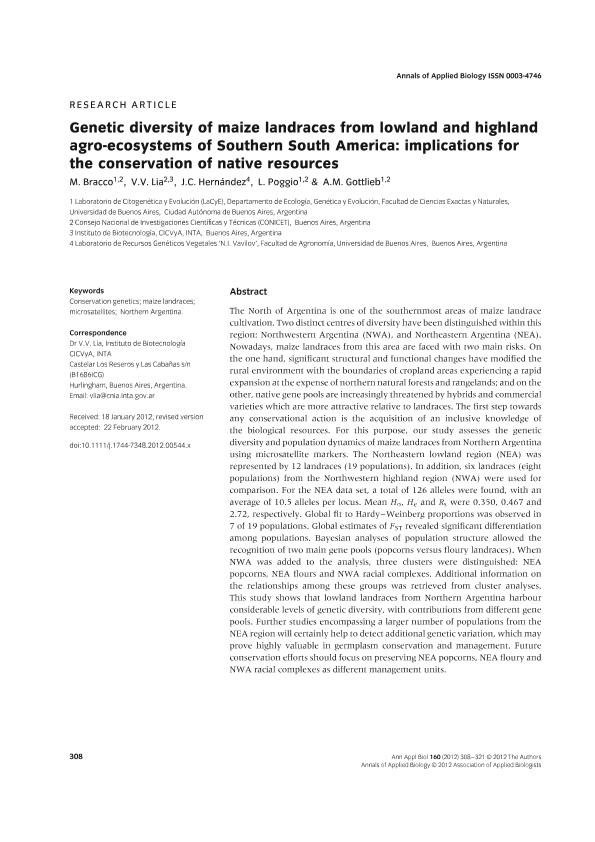Artículo
Genetic diversity of maize landraces from lowland and highland agro-ecosystems of Southern South America: Implications for the conservation of native resources
Bracco, Mariana ; Lia, Verónica Viviana
; Lia, Verónica Viviana ; Hernández, J. C.; Poggio, Lidia
; Hernández, J. C.; Poggio, Lidia ; Gottlieb, Alexandra Marina
; Gottlieb, Alexandra Marina
 ; Lia, Verónica Viviana
; Lia, Verónica Viviana ; Hernández, J. C.; Poggio, Lidia
; Hernández, J. C.; Poggio, Lidia ; Gottlieb, Alexandra Marina
; Gottlieb, Alexandra Marina
Fecha de publicación:
05/2012
Editorial:
Wiley Blackwell Publishing, Inc
Revista:
Annals of Applied Biology
ISSN:
0003-4746
Idioma:
Inglés
Tipo de recurso:
Artículo publicado
Clasificación temática:
Resumen
The North of Argentina is one of the southernmost areas of maize landrace cultivation. Two distinct centres of diversity have been distinguished within this region: Northwestern Argentina (NWA), and Northeastern Argentina (NEA). Nowadays, maize landraces from this area are faced with two main risks. On the one hand, significant structural and functional changes have modified the rural environment with the boundaries of cropland areas experiencing a rapid expansion at the expense of northern natural forests and rangelands; and on the other, native gene pools are increasingly threatened by hybrids and commercial varieties which are more attractive relative to landraces. The first step towards any conservational action is the acquisition of an inclusive knowledge of the biological resources. For this purpose, our study assesses the genetic diversity and population dynamics of maize landraces from Northern Argentina using microsatellite markers. The Northeastern lowland region (NEA) was represented by 12 landraces (19 populations). In addition, six landraces (eight populations) from the Northwestern highland region (NWA) were used for comparison. For the NEA data set, a total of 126 alleles were found, with an average of 10.5 alleles per locus. Mean H o, H e and R s were 0.350, 0.467 and 2.72, respectively. Global fit to Hardy-Weinberg proportions was observed in 7 of 19 populations. Global estimates of F ST revealed significant differentiation among populations. Bayesian analyses of population structure allowed the recognition of two main gene pools (popcorns versus floury landraces). When NWA was added to the analysis, three clusters were distinguished: NEA popcorns, NEA flours and NWA racial complexes. Additional information on the relationships among these groups was retrieved from cluster analyses. This study shows that lowland landraces from Northern Argentina harbour considerable levels of genetic diversity, with contributions from different gene pools. Further studies encompassing a larger number of populations from the NEA region will certainly help to detect additional genetic variation, which may prove highly valuable in germplasm conservation and management. Future conservation efforts should focus on preserving NEA popcorns, NEA floury and NWA racial complexes as different management units.
Palabras clave:
Conservation Genetics
,
Maize Landraces
,
Microsatellites
,
Northern Argentina
Archivos asociados
Licencia
Identificadores
Colecciones
Articulos(IEGEBA)
Articulos de INSTITUTO DE ECOLOGIA, GENETICA Y EVOLUCION DE BS. AS
Articulos de INSTITUTO DE ECOLOGIA, GENETICA Y EVOLUCION DE BS. AS
Articulos(SEDE CENTRAL)
Articulos de SEDE CENTRAL
Articulos de SEDE CENTRAL
Citación
Bracco, Mariana; Lia, Verónica Viviana; Hernández, J. C.; Poggio, Lidia; Gottlieb, Alexandra Marina; Genetic diversity of maize landraces from lowland and highland agro-ecosystems of Southern South America: Implications for the conservation of native resources; Wiley Blackwell Publishing, Inc; Annals of Applied Biology; 160; 3; 5-2012; 308-321
Compartir
Altmétricas



